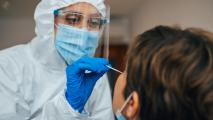It’s our day-to-day COVID catechism: wear a mask, wash your hands, practice social distancing by staying six feet away, slow the coronavirus spread.
It’s simple, but lends itself to being seen in black and white. Do it all, spare yourself and others; ignore it, and throw caution to the winds and public health to the sharks.
Life, however — even a life lived during a pandemic — is not generally so simple.
A team of researchers at the University of Oxford and MIT are the latest to attempt to integrate some nuance into how we manage our activities and social bubbles. And they’ve created a tool, rather than a fixed set of rules, to help inform people’s decisions.
“Instead of single, fixed physical distance rules, we propose graded recommendations that better reflect the multiple factors that combine to determine risk,” the authors wrote in The BMJ.
“This would provide greater protection in the highest risk settings but also greater freedom in lower risk settings, potentially enabling a return towards normality in some aspects of social and economic life.”
Social Distancing: Life 6 Feet Apart
The six-foot rule is based on outdated science, the researchers maintain: guidelines that trace their origin to the late Victorian era — and which were bolstered by high-speed photography, able to capture our droplets, in the 1940s.
“The dogma was born,” Lidia Morawska, an aerosol scientist at Australia’s Queensland University of Technology not involved with the new tool, told Business Insider. “Like any dogma, it’s extremely difficult to change people’s minds and change the dogmas.”
While it’s hard to argue that six feet is wrong, per se — social distancing, along with mask wearing, seem key for countries who have slowed and managed the ravages of COVID-19 — it does provide perhaps more rigid a rule than needed, one which may be slowing a return to some semblance of normal life or, depending on the place (looking at us, AMERICA), inspire rebellion.
The gist is this: transmission is a complex thing, and our assessment of our own risk — and the social distancing and other safety measures we take — should try to reflect that complexity.
“With knowledge and tools that are relatively simple to use, that distill complex information, our hope is that decision makers, local community leaders, school leaders, and everybody that is organizing anything like a barbecue or party or a wedding, is empowered to be more resilient, by having the tools to make the right decisions and to impose the right restrictions,” MIT’s Lydia Bourouiba, an author on the study and director of the Fluid Dynamics of Disease Transmission Lab, told Business Insider.
The COVID-19 Traffic Light
The Oxford and MIT tool joins a raft of others that are attempting to add some nuance by breaking down activities and environments into levels of risk.
Numerous factors impact the chance of catching SARS-CoV-2, the researchers say. These include the size of the respiratory droplets generated, the quality of ventilation, airflow patterns, whether an activity is indoors or outdoors and what kind of activity it is, the density of people, and if they are wearing masks (told you it’s complex).
Breathing, sneezing, coughing, and singing all generate quick-moving clouds of droplets, the researchers wrote; any activities that cause these exhalations, and especially those inside (e.g., the choir practice in Washington state) should be considered high risk.
In essence, the broad strokes remain — masks better than no masks, outdoors better than indoors — but Oxford and MIT’s tool breaks things down using a “traffic light” system. The colors are self explanatory: green is low risk, yellow is moderate risk, red is high risk.
Their social distancing tool resembles a dive table. Breaking things down by occupancy, space (indoors? outdoors? well ventilated? poorly ventilated?), how long you’ll be around folks, and if masks are being worn, your risk is determined to be low, moderate, or high — green, yellow, or red.
Meeting someone outdoors for a normal conversation, and you’re both wearing masks? That’s a green light, even if you chat for a while. Hanging out inside a packed spot for a prolonged amount of time, singing or shouting? That’s a red light, even if you’re all wearing masks and the space is well ventilated.
(Little wonder bars — which are loud, have a crowd, require masks off for drinking, and generally lower inhibitions — are considered potential hot zones, while a nice outdoor park or windy beach seem comparatively safe.)
“This would provide greater protection in the highest risk settings but also greater freedom in lower risk settings, potentially enabling a return towards normality in some aspects of social and economic life,” the researchers wrote in a release on EurekAlert!.
Still, a tool like this isn’t a guarantee of safety; only complete and total isolation could promise that, and that’s just not an option for the vast majority of people, and governments and citizens alike would really prefer to avoid the damage of complete coronavirus lockdowns if possible.
The tool cannot account for everything. Factors like viral load, ventilation strategies, PPE, hand washing — it all comes into play.
But with the world needing to learn to live with COVID-19 for a while and difficult questions encountered every day — is it safe to fly? should I install a new air filter? — smarter social distancing may be a key for any kind of return to normalcy.






